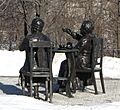Henrietta Edwards facts for kids
Quick facts for kids
Henrietta Edwards
|
|
|---|---|
 |
|
| Born |
Henrietta Louise Muir
18 December 1849 Montreal, Canada East
|
| Died | 10 November 1931 (aged 81) Fort Macleod, Alberta, Canada
|
| Nationality | Canadian |
| Occupation | Suffragist, Author |
| Known for | Women's rights activist |
| Spouse(s) |
Oliver C. Edwards
(m. 1876; died 1915) |
Henrietta Muir Edwards (born December 18, 1849 – died November 10, 1931) was a Canadian leader who fought for women's rights. She was a key person in making life better for women in Canada.
Henrietta was the oldest of "The Famous Five". This group also included Emily Murphy, Nellie McClung, Louise McKinney, and Irene Parlby. They worked together to make sure women were seen as "persons" under the law. This fight also helped women get the right to vote in elections.
She was born Henrietta Louise Muir in Montreal. Her family believed in culture and religion. As she grew up, Henrietta saw that women were often left out of important groups. This made her want to change things.
Early Life and Work
As a young woman, Henrietta and her sister Amélia started a group in Montreal in 1875. It was called the Working Girls’ Association. This group helped young working women by giving them meals and places to read and study. It later became one of Canada's first YWCAs.
They also started a magazine called The Working Women of Canada. This magazine helped show people the difficult working conditions that women faced. Henrietta and her sister paid for this project themselves, using money they earned as artists.
In 1876, Henrietta Edwards married Dr. Oliver C. Edwards. They had three children. In 1883, they moved to Indian Head, which was then part of the North West Territories. Dr. Edwards worked as a doctor for Indigenous communities there. Henrietta kept working for women’s rights on the prairies.
Fighting for Women's Rights
In 1890, the Edwards family moved back to Ottawa, Canada's capital city. Henrietta began to help women who were in prison. She worked with Lady Aberdeen, whose husband was the Governor General. Together, they helped create the National Council of Women of Canada in 1893.
Henrietta was the leader of the Council's section for Laws Governing Women and Children for 35 years. Because she knew so much about these laws, she was also chosen to lead the Provincial Council of Alberta. With Lady Aberdeen, she also helped start the Victorian Order of Nurses (VON) in 1897. This group provides nursing care across Canada.
The Edwards family moved to Fort Macleod, Alberta, in 1904. Her husband worked as a medical officer for the Blood tribe.
During the First World War, Canada needed help saving supplies. The government asked Henrietta Edwards for advice on how to get people to conserve more. This was a big moment because it was the first time a woman was asked to help the government with public policy.
Henrietta Edwards wrote two important books about women and legal issues. These were Legal Status of Canadian Women (1908) and Legal Status of Women in Alberta (1921). She worked with Louise McKinney, Irene Parlby, and Emily Murphy to push the Alberta government to recognize women's rights to property after marriage.
This group of friends later worked together on the famous Persons Case in the late 1920s. This case was a big fight to make sure Canadian women were seen as "persons" under the law. Winning this case meant women could be appointed as senators and hold other important political jobs. It showed that Canadian women had the same rights as men in politics.
As an artist, Henrietta was asked by the Canadian government to paint a set of dishes. These dishes were shown at the 1893 World's Columbian Exposition, a big world's fair.
Henrietta Edwards was buried in Mount Pleasant Municipal Cemetery in Edmonton. Her memorial says, "Let her own works praise her."
Legacy
In 1962, the Canadian government recognized Henrietta Edwards as a Person of National Historic Significance. A special plaque honoring her is at the Fort Macleod Post Office in Alberta.
The "Persons Case," which she helped win, was also recognized as an Historic Event in 1997. In October 2009, the Senate of Canada voted to name Henrietta Edwards and the rest of the Famous Five as Canada's first "honorary senators." This was a special way to honor their important work.
Images for kids
-
Rt. Hon. W.L. Mackenzie King unveiled plaque to the Valiant 5 in the Person's Case
See also
 In Spanish: Henrietta Muir Edwards para niños
In Spanish: Henrietta Muir Edwards para niños



